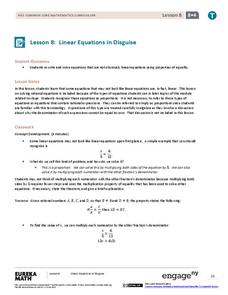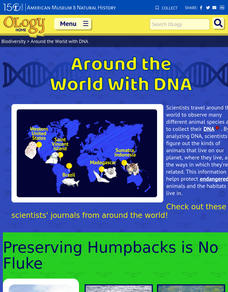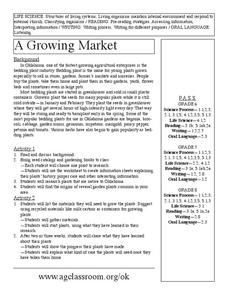University of Colorado
Rings and Things
Galileo first observed Saturn's rings in 1610. Through the use of a flashlight and baby powder, classes see how they can observe the rings of the outer planets from far away. Another demonstration shows how these rings, made of ice and...
EngageNY
Linear Equations in Disguise
In the eighth segment of a 33-part unit, learners look at equations that do not appear to be linear at first glance. The equations are proportions where the numerators and denominators may have more than one term. To round out the...
Intel
Beat the Heat
Explore greenhouse effect and climate change through a 15-day unit. Scholars learn about these STEM concepts by researching, conducting surveys, experimenting, and collaborating with experts in the field. They frequently communicate...
PBS
Reading Adventure Pack: The Lorax
Accompany a reading of The Lorax by Dr. Seuss and Tell Me, Tree by Gail Gibbons with an activity packet designed to bring awareness to nature, specifically trees. Scholars take to the outside, draw lines to create trees reminiscent of...
Chicago Botanic Garden
Recognizing Change (Observation vs. Inference)
What is the difference between making inferences and making observations? Young climatologists refer to a PowerPoint to make observations on each slide. They record their observations in a provided worksheet before drawing a...
NOAA
Motion from the Ocean
Create a fish mobile using cardboard and string to hang in the classroom while studying ocean life. Each printable requires pupils to cut out two of the same fish to create consistency on the front and back.
Macmillan Education
Slang
A four-part worksheet challenges scholars' knowledge of American, Australian, and British slang. Learners use context clues to decide which country a slang word is from, complete sentences, decipher a conversation, and answer questions.
Stephen F. Austin State University, College of Fine Arts
The Ugly Duckling
It's not about what you look like on the outside! A study guide for the stage adaptation of The Ugly Duckling reminds learners that being cruel to those in need is not helpful—and that we all belong somewhere.
College Board
Is That an Assumption or a Condition?
Don't assume your pupils understand assumptions. A teacher resource provides valuable information on inferences, assumptions, and conditions, and how scholars tend to overlook these aspects. It focuses on regression analysis, statistical...
Poetry4kids
How to Write a Tanka Poem
Take your haikus to the next level with tanka poems, another form of Japanese poetry that regulates the length and rhythm of each line by syllables. Young writers read the explanation, examples, and tips for tanka poems before writing...
DiscoverE
Design a Wind Turbine
Discover the power of wind energy. Learners design, build, and test wind blades in a hands-on experiment. They analyze the results to determine if they can make any improvements before gathering as a class to discuss their designs.
American Museum of Natural History
Around the World with DNA
DNA analysis could be what saves some animals from extinction. An interactive lesson shows learners how DNA information proves variation among animals of the same species and how stakeholders use that information to make decisions. Easy...
American Museum of Natural History
Layer of Time
Dig through the layers for a better understanding of fossils. Scholars learn that fossils form in layers of sedimentary rock. Pupils arrange virtual layers to show the fossil record of different species. Once the layers are correct, they...
American Museum of Natural History
Around with World with DNA
A mammalogist, ornithologist, ichthyologist, and a conservation geneticist share their work and their hopes that their research will help protect and save endangered species and their habitats.
EngageNY
Performance Task Preparation: Peer Critique and Mini-Lesson Addressing Common Errors: Revising Draft Essay to Inform
Time to revise! Using a writing evaluation rubric, scholars participate in a peer editing process to provide feedback on each others' informative essays. Next, pupils begin revising their drafts based on the feedback they receive.
Curated OER
Life Lessons: Imagination
Students look at clouds and find some that are shaped like various items. They also pretend they are animals and make movements and sounds to resemble the animals.
Curated OER
Lets Think About...Plants
Students bring in various vegetables and make friendship soup. They plant seeds and discuss the things plants need to grow and thrive.
Curated OER
A Growing Market
Students research plants and the bedding plant industry and then make a list of materials they need to plant seeds. In this planting lesson plan, students then plant their seeds, chart their progress, and write what they have learned.
Curated OER
Hatching Chickens
Students consider the concept that much can be learned from the natural world by observation. They observe the incubation and hatching of chicken eggs in the classroom and discuss the needs of living things.
Curated OER
Animals A to Z: Penguin
In this penguin worksheet, 3rd graders will add pages to their "animal books." Students will read 10 facts to gain an understanding of a penguin and its particular attributes.
Curated OER
'I'm Just Totally Lost' About Finances
Explore the concept of financial planning with your class. High schoolers read an article about planning for the financial future and discuss what steps the family in the article took to be financially sound. They consider where they...
Curated OER
Friendship and Belonging
Students identify and demonstrate various emotions. In this philanthropy lesson, students listen to the book, The Brand New Kid by Katie Couric, and brainstorm ideas to help new children feel welcome at school. Students role play the...
Curated OER
Shizuko’s Daughter: Selective Reading Guide
Examine the text of Kyoko Mori's Shizuko's Daughter with a reading guide. With questions that prompt kids to refer to the reading as well as to their own experiences and opinions, the guide is an effective way to keep them engaged with...
Curated OER
ExplorA-Pond:3rd Grade Shapes & Fractions
Learners, using a map, drawing or aerial view of a pond, represent the shape of the pond using simple geometric shapes or fractions of those shapes. They identify the numerator and denominator in each fraction created.

























